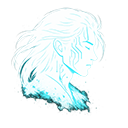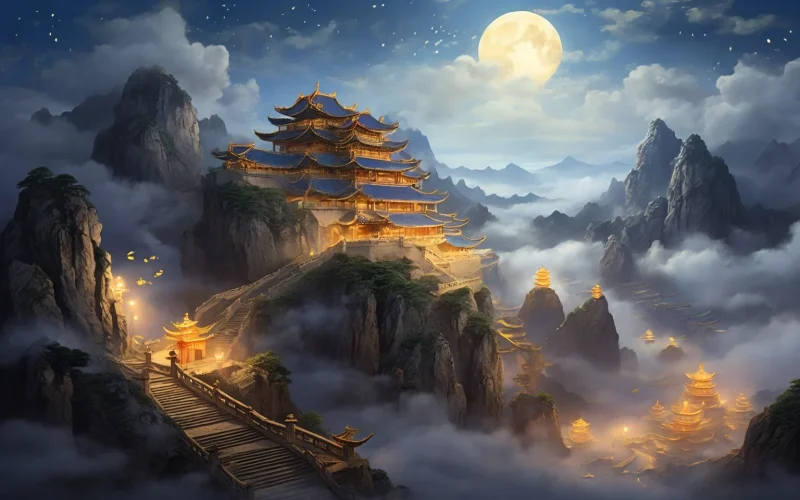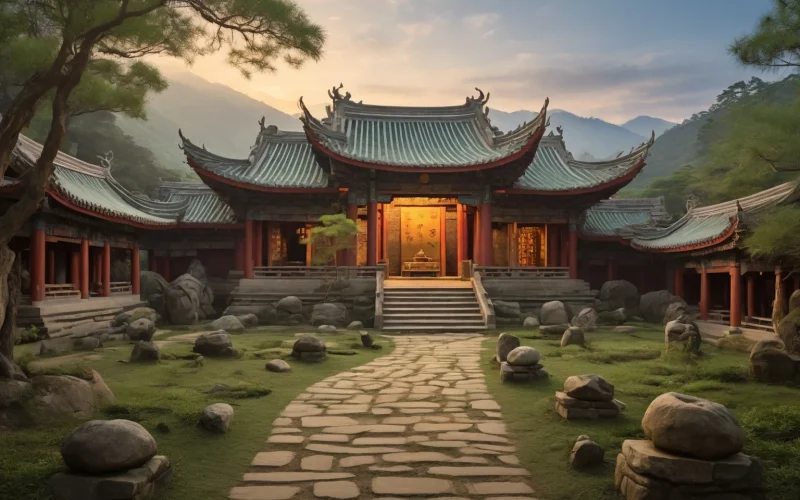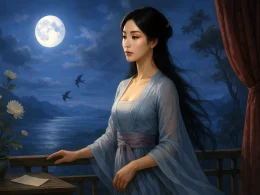The world’s a lotus treasury divine,
Where pilgrims light incense to form karmic ties.
The Lamp King’s radiance knows no confine—
At midnight, silence spreads the Buddha’s sighs.
Original Poem
「满公房」
綦毋潜
世界莲花藏,行人香火缘。
灯王照不尽,中夜寂相传。
Interpretation
This seven-character quatrain, composed during the poet’s visit to a Buddhist temple, distills the essence of a sacred nightscape into twenty-eight characters. "Man Gong’s Chamber" (满公房) likely refers to a revered monk’s abode or a hall of worship, where lotus flowers, incense, and the "King of Lamps" merge into a tableau of spiritual transcendence. Through sparse yet evocative imagery, Feng captures both the physical serenity of the temple and its metaphysical resonance—where light and silence become conduits for enlightenment.
First Couplet: "世界莲花藏,行人香火缘。"
Shì jiè lián huā zàng, xíng rén xiāng huǒ yuán.
The world is a treasury of lotus blossoms—
each pilgrim’s incense kindles a bond with the divine.
The opening line invokes the Lotus Treasury World (莲花藏世界), a central concept in Huayan Buddhism, where the universe is envisioned as an infinite net of interconnected lotus realms, each bearing a Buddha. By framing the temple as part of this cosmic matrix, Feng elevates the scene from mere description to spiritual allegory. The "lotus" (莲花), unsullied by the mud from which it grows, symbolizes purity amid worldly defilement—a metaphor for the mind’s potential for awakening.
The second line, "each pilgrim’s incense kindles a bond," underscores the reciprocal relationship between the sacred and the mundane. "Incense" (香火) represents both devotional acts and the ephemeral nature of human aspirations, while "bond" (缘) alludes to karmic connections—the idea that even fleeting encounters are threads in the vast fabric of causality.
Second Couplet: "灯王照不尽,中夜寂相传。"
Dēng wáng zhào bù jìn, zhōng yè jì xiāng chuán.
The King of Lamps shines inexhaustibly—
at midnight, silence itself becomes his messenger.
Here, Feng introduces the "King of Lamps" (灯王), a colossal ceremonial lamp symbolizing the Buddha’s wisdom, which pierces the darkness of ignorance. Its light is "inexhaustible" (照不尽), paralleling the Huayan teaching that the Dharma radiates infinitely across time and space. The paradoxical pairing of "midnight" (中夜)—the darkest hour—with the lamp’s glow suggests that enlightenment persists even in obscurity.
The final line, "silence itself becomes his messenger," is a masterstroke. In Buddhist practice, silence (śūnyatā) is not mere absence but a medium for profound truth. By personifying silence as a "messenger," Feng implies that the deepest teachings transcend language, transmitted through the stillness between thoughts.
Holistic Appreciation
This poem depicts a solemn and luminous realm through the nocturnal scenery of a Buddhist temple. The opening couplet begins with the grand vision of "the world as a lotus treasury," unfolding a majestic scene, while the "karmic bond of incense and flame" introduces human emotion and participation. The second couplet culminates in "the Lamp King" and "midnight silence," contrasting light and stillness to convey the profundity and timelessness of the sacred realm.
Rich in Buddhist imagery yet infused with the poet’s contemplative immersion, the poem condenses both visual splendor and philosophical depth into just twenty-eight characters. Its language is unadorned yet evokes spiritual resonance through religious symbolism.
Artistic Merits
- Rich Buddhist Symbolism
The lotus, incense, and Lamp King are all Buddhist emblems, constructing a Pure Land atmosphere. - Dynamic Interplay of Movement and Stillness
The fervor of incense contrasts with the deep silence of midnight, creating distinct layers. - Fusion of Symbolism and Realism
It is both a realistic depiction of a night in a temple and an allegory for the eternal light of wisdom and the mind. - Concise Language, Profound Meaning
With minimal brushstrokes, it sketches the ethereal and enduring nature of the Buddhist realm.
Insights
This poem demonstrates how the fusion of beauty and religious imagery can evoke spiritual awe. It reminds us that true beauty lies not merely in visual splendor but in inner purification and tranquility. The lotus, the eternal lamp, and the silent night together symbolize wisdom and illumination transcending time and space—an undying light.
As readers appreciate this poem, they may also reflect on the need to preserve a space of inner clarity and enduring light amid worldly clamor—a spiritual beacon within, guiding us through the dust of mortal life.
About the Poet

Qiwu Qian (綦毋潜 692–c. 755), a native of Ganzhou (modern-day Ganzhou, Jiangxi), was a representative poet of the Landscape and Pastoral School during the High Tang period. He earned the jinshi degree in 726 (the 14th year of the Kaiyuan era) and held official positions such as Right Reminder (You Shiyi) and Editorial Director (Zhuzuo Lang) before retiring to the Jiangnan region. His poetry, renowned for its depictions of reclusive life and natural landscapes, is characterized by a serene and understated style. He exchanged poetic works with Wang Wei, Meng Haoran, and other literary figures. The Complete Tang Poems (Quan Tangshi) preserves 26 of his poems, which stand out distinctly within the High Tang landscape poetry tradition and significantly influenced the development of later Zen-inspired poetry.












